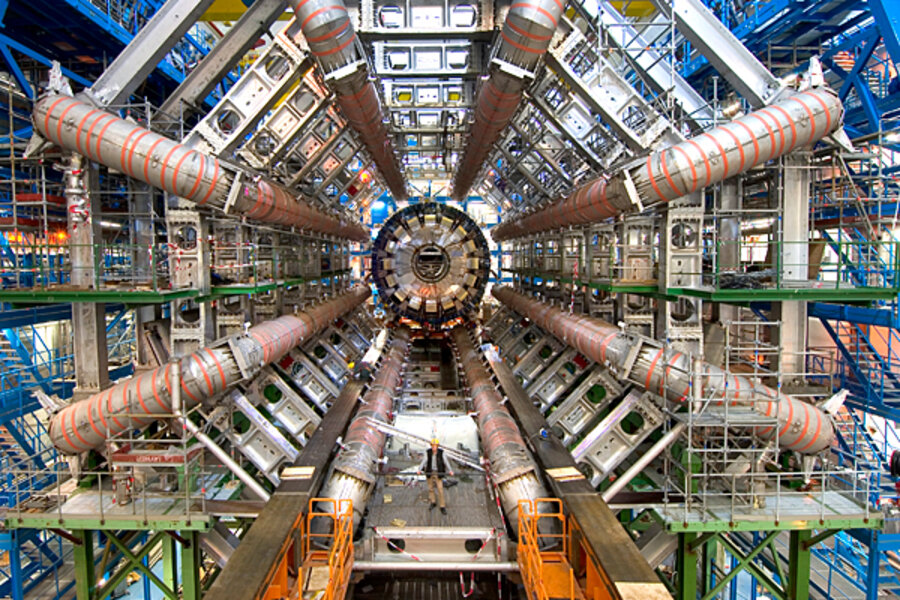Large Hadron Collider not large enough, say scientists who want a Humongous Hadron Collider
Loading...
| Paris
Scientists behind the European particle collider aimed at uncovering the secrets of the universe pushed Monday to build an even bigger machine — with money and partners from around the world.
Instead of whirling atoms in giant rings, as existing colliders in Switzerland and the United States do, scientists want a new-generation machine that will shoot them straight.
Particle physicists gathering in Paris on Monday for the most important conference in their field say a linear atom blaster is needed to complement what existing colliders are telling scientists about the universe, inching them closer to understanding why we are here.
IN PICTURES: The Large Hadron Collider
Mel Shochet, a professor at the University of Chicago, said "this is by far the most exciting time" in his particle physics career.
Speaking at a Paris news conference, Shochet said "exciting new phenomena" would be seen first by existing colliders "and then followed up in great detail" by future machines, he said at a Paris press conference.
Depending on who wants to host it — and how much they are willing to pay — the next-generation collider could potentially be built anywhere in the world — with Japan, Russia, the U.S. and Switzerland all possible hosts for the most advanced project.
Scientists are fortified by the results of the $10 billion Large Hadron Collider run by CERN, a particle physics laboratory outside Geneva. A smaller collider called Tevatron is run by Fermilab near Chicago. Both are highly complex machines that took years to bring to fruition.
Rolf Heuer, head of CERN, said he is "pretty happy" about what scientists have so far discovered in Switzerland.
"This is a dark universe" into which the machine "will shed the first light," he said.
It will be the "interplay and combination of results" between the two different types of atom smashers that allows high-energy physics to advance, he said.
More than 1,000 physicists have gathered in Paris to hear the latest findings from the colliders — and the preparations for their successors — at the International Conference on High Energy Physics, which runs through July 28.
The experiments are more about shaping our understanding of how the universe was created than immediate improvements to technology in our daily lives.
Scientists are attempting to simulate the moments after the Big Bang nearly 14 billion years ago, which they theorize was the creation of the universe.
Plans for the next step include a €10 billion ($12.85 billion), 50-kilometer (31-mile) tunnel called the International Linear Collider, and the Compact Linear Collider, or CLIC, which is as yet uncosted.
"Both are now really international cooperations, collaborations," said Heuer.
He said plans for the ILC, which first originated in a Hamburg laboratory, are more technologically advanced, but the rival collider aims at higher-energy experiments.
The choice will be determined by the discoveries at CERN, or the European Organization for Nuclear Research, he said.
Barry Barish, director of the proposed ILC, told The Associated Press that scientists could have the technology ready to go ahead with his project in 2012.
"If we are going to build an ambitious machine, then it's got to be a global machine," said Barish, a professor at the California Institute of Technology.
The rival project could be five to 10 times more powerful than the ILC — depending on how much funding is available, according to Jean-Pierre Delahaye, CLIC study leader at CERN, who is involved in both projects.
"When we go up in energy, we get closer to the Big Bang moment," he told the AP.
French President Nicolas Sarkozy, speaking at the conference on Monday, vowed to keep investing in science despite the need to reduce public spending. But investments of the scale being discussed in Paris "can't be made by a single country, not even by a small group of countries," he said.
The collider under the Swiss-French border was launched with great fanfare in September 2008, but days later was sidetracked by overheating that set off a chain of problems. CERN had to undertake a $40 million program of repairs and improvements before restarting the machine in November. Since then the collider has reported a series of successes.
In March, the Large Hadron Collider produced its first bang, the most potent force on the tiny atomic level that humans have ever created.
Two beams of protons were sent hurtling in opposite directions toward each other in a 17-mile (27-kilometer) tunnel below the Swiss-French border — the coldest place in the universe at slightly above absolute zero.
CERN used powerful superconducting magnets to force the two beams to cross; two of the protons collided, producing 7 trillion electron volts.
Instead of crashing protons together, the planned new colliders will accelerate electrons and positrons, their antimatter equivalent, Guy Wormser, a leading particle physicist and one of the conference organizers, explained.
Heuer said that CERN's experiments so far have "done an incredible job," locating the particles scientists already knew existed. Now their job is to find new ones.
Scientists are searching for the Higgs boson, a hypothetical particle — often called the God particle — that scientists theorize gives mass to other particles and thus to other objects and creatures in the universe.
The colliders also may help scientists see dark matter, the strange stuff that makes up more of the universe than normal matter but has not been seen on Earth.
Researchers of Fermilab haven't found Higgs, but they have narrowed the range of masses in which the particle could exist, said the University of Chicago's Shochet.
"Your work represents the oldest dream of man since he tried to understand and transform what goes on around him," Sarkozy said. "Why is there something rather than nothing?"
IN PICTURES: The Large Hadron Collider
Related





